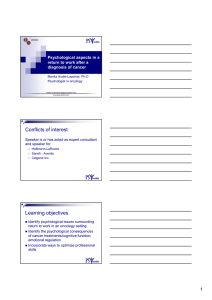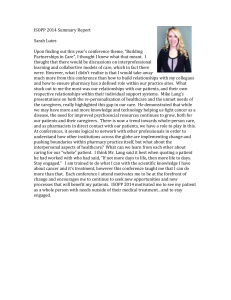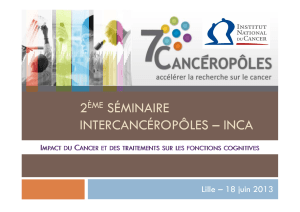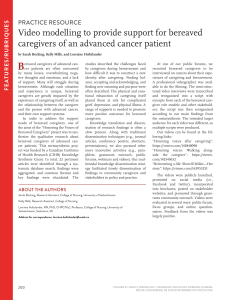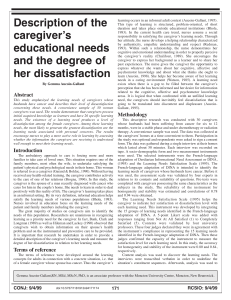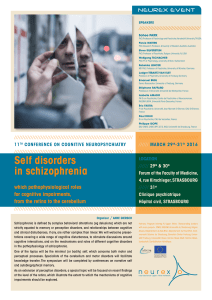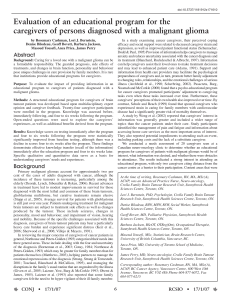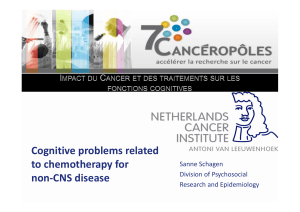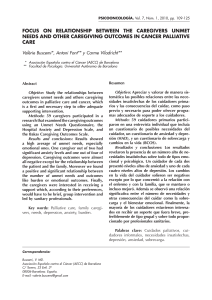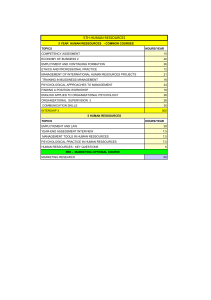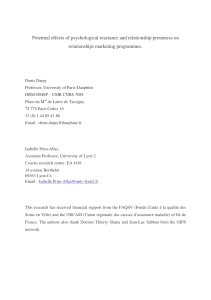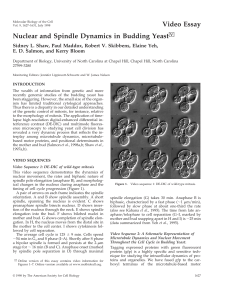Factors associated with self-perceived burden to the primary
publicité
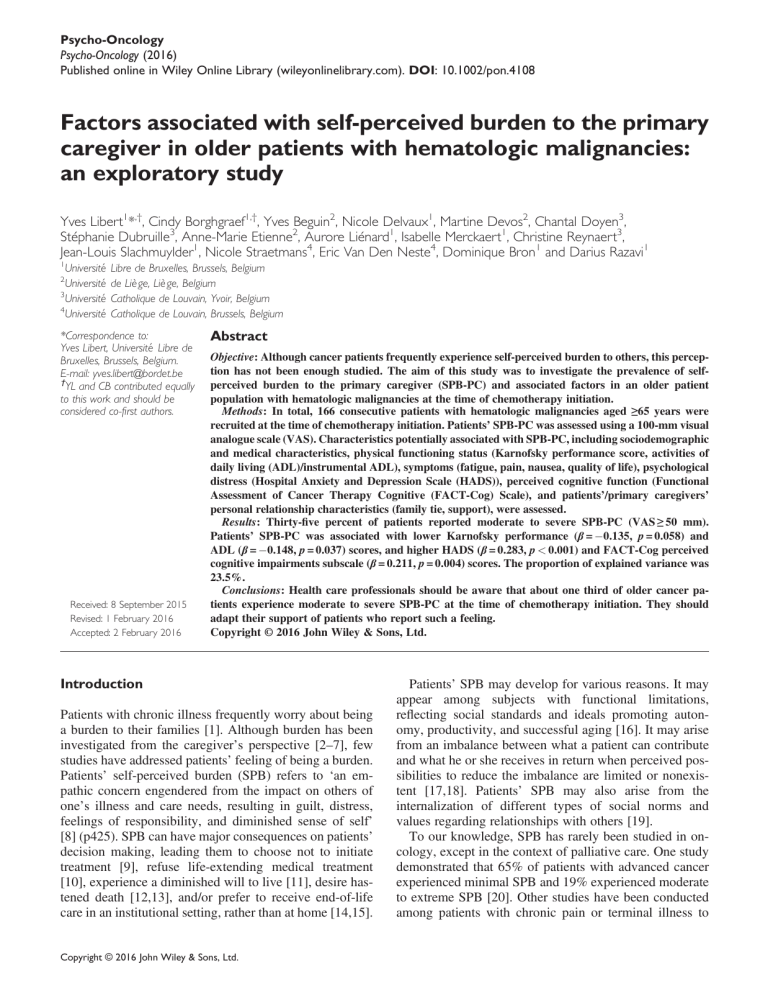
Psycho-Oncology Psycho-Oncology (2016) Published online in Wiley Online Library (wileyonlinelibrary.com). DOI: 10.1002/pon.4108 Factors associated with self-perceived burden to the primary caregiver in older patients with hematologic malignancies: an exploratory study Yves Libert1*,†, Cindy Borghgraef1,†, Yves Beguin2, Nicole Delvaux1, Martine Devos2, Chantal Doyen3, Stéphanie Dubruille3, Anne-Marie Etienne2, Aurore Liénard1, Isabelle Merckaert1, Christine Reynaert3, Jean-Louis Slachmuylder1, Nicole Straetmans4, Eric Van Den Neste4, Dominique Bron1 and Darius Razavi1 1 Université Libre de Bruxelles, Brussels, Belgium Université de Liège, Liège, Belgium 3 Université Catholique de Louvain, Yvoir, Belgium 4 Université Catholique de Louvain, Brussels, Belgium 2 *Correspondence to: Yves Libert, Université Libre de Bruxelles, Brussels, Belgium. E-mail: [email protected] † YL and CB contributed equally to this work and should be considered co-first authors. Received: 8 September 2015 Revised: 1 February 2016 Accepted: 2 February 2016 Abstract Objective: Although cancer patients frequently experience self-perceived burden to others, this perception has not been enough studied. The aim of this study was to investigate the prevalence of selfperceived burden to the primary caregiver (SPB-PC) and associated factors in an older patient population with hematologic malignancies at the time of chemotherapy initiation. Methods: In total, 166 consecutive patients with hematologic malignancies aged ≥65 years were recruited at the time of chemotherapy initiation. Patients’ SPB-PC was assessed using a 100-mm visual analogue scale (VAS). Characteristics potentially associated with SPB-PC, including sociodemographic and medical characteristics, physical functioning status (Karnofsky performance score, activities of daily living (ADL)/instrumental ADL), symptoms (fatigue, pain, nausea, quality of life), psychological distress (Hospital Anxiety and Depression Scale (HADS)), perceived cognitive function (Functional Assessment of Cancer Therapy Cognitive (FACT-Cog) Scale), and patients’/primary caregivers’ personal relationship characteristics (family tie, support), were assessed. Results: Thirty-five percent of patients reported moderate to severe SPB-PC (VAS ≥ 50 mm). Patients’ SPB-PC was associated with lower Karnofsky performance (β = 0.135, p = 0.058) and ADL (β = 0.148, p = 0.037) scores, and higher HADS (β = 0.283, p < 0.001) and FACT-Cog perceived cognitive impairments subscale (β = 0.211, p = 0.004) scores. The proportion of explained variance was 23.5%. Conclusions: Health care professionals should be aware that about one third of older cancer patients experience moderate to severe SPB-PC at the time of chemotherapy initiation. They should adapt their support of patients who report such a feeling. Copyright © 2016 John Wiley & Sons, Ltd. Introduction Patients with chronic illness frequently worry about being a burden to their families [1]. Although burden has been investigated from the caregiver’s perspective [2–7], few studies have addressed patients’ feeling of being a burden. Patients’ self-perceived burden (SPB) refers to ‘an empathic concern engendered from the impact on others of one’s illness and care needs, resulting in guilt, distress, feelings of responsibility, and diminished sense of self’ [8] (p425). SPB can have major consequences on patients’ decision making, leading them to choose not to initiate treatment [9], refuse life-extending medical treatment [10], experience a diminished will to live [11], desire hastened death [12,13], and/or prefer to receive end-of-life care in an institutional setting, rather than at home [14,15]. Copyright © 2016 John Wiley & Sons, Ltd. Patients’ SPB may develop for various reasons. It may appear among subjects with functional limitations, reflecting social standards and ideals promoting autonomy, productivity, and successful aging [16]. It may arise from an imbalance between what a patient can contribute and what he or she receives in return when perceived possibilities to reduce the imbalance are limited or nonexistent [17,18]. Patients’ SPB may also arise from the internalization of different types of social norms and values regarding relationships with others [19]. To our knowledge, SPB has rarely been studied in oncology, except in the context of palliative care. One study demonstrated that 65% of patients with advanced cancer experienced minimal SPB and 19% experienced moderate to extreme SPB [20]. Other studies have been conducted among patients with chronic pain or terminal illness to Y. Libert et al. assess factors associated with SPB [21–23]. Among sociodemographic characteristics, an association was found with living only with a spouse (suggesting a higher SPB when patients lived only with their spouse versus only with other family members versus with their spouse and with other family members) [24], whereas associations with age, gender, marital status, and education level have often been contradictory or absent [21–25]. Among psychological characteristics, patients’ SPB has been correlated with psychological distress [26], depression, worry about the future, decreased ability to concentrate [21], poor perceived quality of life (QOL) [22], loss of control, loss of dignity, hopelessness [25], and suicidal ideation [27,28]. Associated medical characteristics include a large number of comorbid conditions [22] and the presence of physical symptoms, such as pain, weakness, dyspnea [25], and functional limitation [23,29]. One study found no association between physical symptoms and SPB among terminally ill patients [21]; the authors suggested that the impact of physical symptoms on SPB may have been outweighed by psychological discomfort. Among relationship characteristics, patients’ SPB has been associated with greater caregiver burden [23]. Available studies addressing patients’ SPB have methodological limitations. They have been conducted as case studies [30], and they have focused mainly on patients with terminal [30,31] or chronic [23,32] illness. Thus, the conclusions of these studies are not generalizable to other medical settings. Moreover, the persons to which patients refer when reporting SPB (primary caregiver versus others) have not been identified systematically. SPB of older patients with cancer requires the attention of researchers and health care professionals for several reasons. First, older patients with cancer are potentially at greater risk of being a burden to their family and friends for long periods of time, considering their frequent loss of autonomy, physical and psychological discomfort, and frailties. Second, SPB may be a factor triggering suicide, which is frequent among older patients with cancer [33]. Third, as SPB has been shown to influence medical decision making, it must be better addressed in settings devoted to the care of older patients with cancer. Knowledge about SPB is important to improve the quality of support provided by health care professionals. The aim of this study was to assess the prevalence of self-perceived burden to the primary caregiver (SPB-PC) in older patients with hematologic malignancies at the time of chemotherapy initiation. First, it has been chosen to look specifically to SPB-PC to study a precise subjective feeling which may be useful to consider in patients and their primary caregivers support. Second, the time of chemotherapy initiation was chosen because patients were considered by physicians to be sufficiently fit for the initiation of a new treatment, and their treatment response could be considered as a possible positive outcome. The Copyright © 2016 John Wiley & Sons, Ltd. treatment initiation period was thus considered suitable for the assessment of SPB-PC and associated factors to optimize support provided to patients and caregivers. Third, although there is not a strong rationale to study specifically a hematological population, such a population – versus a population presenting solid tumors – was considered for the purpose of this study as illness perception and symptoms burden may be specific [34]. Given the current lack of models to explain SPB-PC in older patients with cancer, we conducted exploratory analyses to assess associations with patient and patients’/primary caregivers’ personal relationship characteristics. Most of factors reported in the literature as associated with SPB have been therefore considered. Methods Patients and setting This study was conducted in six Belgian hospitals and was approved by the local ethics committee. All consecutive patient volunteers fulfilling the inclusion criteria were invited to participate and provided written informed consent. Recruited patients were aged ≥65 years, had hematologic malignancies, had been admitted for chemotherapy initiation, and were able to speak French. Patients hospitalized for palliative care, those with diagnoses of severe dementia, and those who could not complete scheduled assessments for physical or psychological reasons were excluded. The assessment conducted by several independent investigators was conducted during the 48 h around chemotherapy initiation and lasted approximately 1 – 1.5 h. Therefore the assessment might have been conducted after the chemotherapy initiation. In order to avoid bias, self-reported questionnaires were used. Moreover the investigators were trained in order to standardize the way to present the study and the assessment. Considering the requirements of the local ethics committee, no information on non-respondents was collected. Assessment tools Self-perceived burden to the primary caregiver As the study was run in French, the use of a 100-mm visual analogue scale (VAS; ranging from ‘not at all’ to ‘a lot’) was chosen in order to minimize cross-languages ordinal and interval differences of response choices of a 5point Likert scale. Patients’ sociodemographic and medical characteristics Patients provided demographic information, including age, gender, educational level, marital status, and living status. Physicians provided patients’ medical characteristics including diagnosis, time since diagnosis, disease status, prognosis, and number of comorbidities. Such as Psycho-Oncology (2016) DOI: 10.1002/pon Self-perceived burden in older cancer patients SPB-PC, VAS assessing patients’ symptoms were used firstly to minimize cross-languages ordinal and interval differences of response choices and second to avoid a too long assessment period. Four VAS were used in order to assess current patients’ levels of fatigue (ranging from ‘not at all’ to ‘a lot’), pain (ranging from ‘not at all’ to ‘a lot’), nausea (ranging from ‘not at all’ to ‘a lot’), and QOL (ranging from ‘very bad’ to ‘excellent’). Patients’ physical functioning status and psychological characteristics Patients’ physical functioning status and psychological characteristics were assessed using validated tools: Karnofsky performance score, activities of daily living (Katz ADL [35] (total score ranged from 6 to 24) and Lawton IADL [36] (total score ranged from 8 to 32); higher score indicated better physical functioning status), Functional Assessment of Cancer Therapy Cognitive Scale version 3 (FACT-Cog), Hospital Anxiety and Depression Scale (HADS; higher score indicated higher psychological distress) [37]. As most of these tools are well known, only the FACT-Cog Scale will be detailed here. The FACT-Cog Scale is a self-reported measure of cognitive impairments and its impact on patients QOL. This 37-item instrument assesses patients’ memory, attention, concentration, language, and thinking abilities during the last 7 days. It consists of four subscales: perceived cognitive impairments (20 items; score range 0–80; higher score indicated frequent perceived impairments) and comments from others (4 items; score range 0–16; higher score indicated frequent comments from others) subscales; and perceived cognitive abilities (9 items; score range 0–36; higher score indicated higher perceived cognitive abilities) and impact on QOL (4 items; score range 0–16; higher score indicated higher impact on QOL) subscales [38]. The FACT-Cog questionnaire has been translated into French and validated with French-speaking patients with cancer [39]. Patients’/primary characteristics caregivers’ personal relationship Patients were asked to characterize their personal ties with primary caregivers and to report the frequency of encounters (responses were grouped into two categories (a) ‘less than every day’ versus (b) ‘every day’), frequency of discussions about the disease (responses were grouped into two categories (a) ‘never, rarely or sometimes’ versus (b) ‘often or always’), frequency with which the primary caregiver helped the patient (responses were grouped into two categories (a) ‘never, rarely or sometimes’ versus (b) ‘often or always’) and assessment of the primary caregiver’s ability to perceive the patient’s difficulties (responses were grouped into two categories (a) ‘excellent, very good or good’ versus (b) ‘average or poor’). Copyright © 2016 John Wiley & Sons, Ltd. Statistical analysis There is no available recommendation on how to consider moderate to severe SPB-PC. Therefore, to assess the prevalence of moderate to severe SPB-PC, a cut-off score of ≥50 mm was chosen to consider a probably clinically significant SPB-PC. To assess associated factors, SPB-PC was considered as a continuous variable. Univariate relationships between patient characteristics and SPB-PC were evaluated using non-parametric tests (e.g. Spearman correlations, Mann–Whitney or Kruskal–Wallis test). All tests were two tailed and alpha was set at 0.05. A backward stepwise linear regression model was then computed to assess relationships between potential predictors and patients’ SPB-PC. All variables with univariate p-values ≤ 0.05 were entered into the model. Variables were not entered in the model as separate blocks and no logtransformation was needed. Analyses were performed with SPSS software (version 20.0 for Windows; SPSS, Chicago, IL). Results Subjects Among 293 eligible inpatients, 98 refused to take part in the study. Performance status of patients who refused to take part to a time consuming assessment well described in the consent form was certainly lower than the performance status of included patients. Twenty patients withdrew from assessments for various reasons: three patients considered the duration of the assessment as too long, eight patients considered not being physically able to continue the assessment, three patients considered not being psychologically able to continue the assessment, four patients gave other reasons (personal reasons …). The two last patients gave multiple reasons (duration of evaluation and physical state versus physical, psychological state and other). Nine patients were excluded from statistical analyses because they did not identify their primary caregiver. Thus, analyses included 166 patients who could be admitted in day care or inpatients settings according to their diagnosis and treatments. Table 1 lists patients’ sociodemographic, medical, physical functioning status, and psychological (SPB-PC, psychological distress, perceived cognitive function) characteristics. Prevalence of self-perceived burden to the primary caregiver (SPB-PC) At the start of chemotherapy, 35% of participants experienced moderate to severe SPB-PC (VAS ≥ 50 mm). The mean VAS score for the total sample (35 mm; Std = 35 mm) indicated clinically significant SPB-PC, with 19% of participants scoring in the highest quarter (75–100 mm), 16% in the third quarter (50–74 mm), Psycho-Oncology (2016) DOI: 10.1002/pon Y. Libert et al. Table 1. Characteristics of older patients with cancer (n = 166) n Sociodemographic characteristics Age Gender Male Female Marital status Single, divorced, separated, or widowed Married Educational level Junior high school or less High school graduation or more Living status Living alone Not living alone Medical characteristics Diagnosis Lymphoma, multiple myeloma, chronic lymphocytic leukemia Acute myelogenous leukemia, chronic myelomonocytic leukemia, myelodysplasia Acute lymphocytic leukemia Months since diagnosis Disease status Complete remission, partial remission, minor remission or no change In progression Too early to evaluate Prognosis <1 year ≥1 year Too early to evaluate Number of comorbidities Treatments Chemotherapy Autologous bone marrow transplant Allogeneic bone marrow transplant Symptom assessment1 Fatigue Pain Nausea Quality of life Physical functioning status Karnofsky performance score Activities of daily living Instrumental activities of daily living % 97 69 58 42 43 123 26 74 104 62 63 37 39 127 23 76 131 Std 73 6 29 17 6 4 Sociodemographic characteristics Age Gender Male Female Marital status Single, divorced, separated, or widowed Married Educational level Junior high school or less High school graduation or more Living status Living alone Not living alone 22 16 10 28 122 17 73 9 58 99 5 35 60 3 154 8 4 46 2 93 5 2 Abbreviation: Std, standard deviation; VAS, visual analogue scale. 1 Assessed on a visual analogue scale (100 mm). 2 Hospital Anxiety and Depression Scale. 3 Functional Assessment of Cancer Therapy Cognitive Scale. *Missing data for one patient. Self-perceived burden to the primary caregiver (100-mm VAS) Mean 79 Psychological characteristics Psychological distress2* Perceived cognitive function3 Perceived cognitive impairments Comments from others Perceived cognitive abilities Impact on quality of life Self-perceived burden to the primary caregiver1 Copyright © 2016 John Wiley & Sons, Ltd. Mean Table 2. Sociodemographic and medical characteristics associated with self-perceived burden to the primary caregiver among older patients with cancer (Mann–Whitney test, Kruskal–Wallis test or Spearman rho as appropriate; n = 166) 50 19 8 63 31 27 17 27 81 24 31 15 1 1 12 7 11 0.38 25 3 35 12 1 7 4 35 Medical characteristics Diagnosis Lymphoma, multiple myeloma, chronic lymphocytic leukemia Acute myelogenous leukemia, chronic myelomonocytic leukemia, myelodysplasia Acute lymphocytic leukemia Months since diagnosis Disease status Complete remission, partial remission, minor remission or no change In progression Too early to evaluate Prognosis <1 year ≥1 year Too early to evaluate Number of comorbidities Treatments Chemotherapy Autologous bone marrow transplant Allogeneic bone marrow transplant Symptom assessment1 Fatigue Pain Nausea Quality of life Std Rho 0.05 32 39 33 36 37 34 37 34 34 36 35 34 36 34 36 35 36 34 34 36 23 35 p 0.510 0.282 0.621 0.418 0.897 0.523 0.06 38 34 38 33 31 36 37 32 36 37 32 36 0.444 0.506 0.158 35 46 15 0.10 0.219 0.547 0.24 0.19 0.16 0.33 0.002 0.016 0.040 <0.001 35 40 12 Abbreviation: Std, standard deviation; VAS, visual analogue scale. 1 Assessed on a visual analogue scale (100 mm). 15% in the second quarter (25–49 mm), and 22% in the lowest quarter (1–24 mm). Twenty-eight percent of patients reported no SPB-PC. Factors associated with SPB-PC Table 2 displays sociodemographic and medical characteristics associated with patients’ SPB-PC at the start of chemotherapy. Correlations between SPB-PC and Psycho-Oncology (2016) DOI: 10.1002/pon Self-perceived burden in older cancer patients Table 3. Functional autonomy, psychological, and relationship characteristics associated with self-perceived burden to the primary caregiver among older patients with cancer (Mann–Whitney test or Spearman rho as appropriate; n = 166) Table 4. Characteristics associated with self-perceived burden to the primary caregiver among older patients with cancer (linear regression model, n = 165) Self-perceived burden to the primary caregiver (100-mm VAS) Self-perceived burden to the primary caregiver (100-mm VAS) Mean Std Physical functioning status Karnofsky performance score Activities of daily living Instrumental activities of daily living Psychological characteristics Psychological distress1* Perceived cognitive function2 Perceived cognitive impairments Comments from others Perceived cognitive abilities Impact on quality of life Patient/primary caregiver relationship characteristics Family tie Partner Other Frequency of encounters3 Less than every day Every day Frequency of discussions about difficulties3 Never, rarely, or sometimes Often or always Frequency of caregivers’ support3 Never, rarely, or sometimes Often or always Caregivers’ ability to perceive patients’ difficulties3 Very good, excellent, or good Average or poor Rho p 0.24 0.23 0.24 0.002 0.003 0.002 0.41 <0.001 0.29 0.18 0.23 0.25 <0.001 0.024 0.003 0.001 0.423 33 38 34 36 37 34 35 35 0.668 0.160 30 40 33 36 31 37 33 35 0.435 0.766 34 35 33 35 Abbreviation: VAS, visual analogue scale. 1 Hospital Anxiety and Depression Scale. 2 Functional Assessment of Cancer Therapy Cognitive Scale. 3 As reported by patients. *Missing data for one patient. sociodemographic characteristics were not significant. Among medical characteristics, only symptoms (fatigue, pain, nausea, and QOL) were correlated significantly with SPB-PC (r = 0.16 to 0.33). Table 3 lists physical functioning status, psychological, and patient/primary caregiver relationship characteristics associated with SPB-PC. All physical functioning and psychological variables were correlated significantly (r = 0.18 to 0.41). Some data (HADS) were missing for only one patient. No significant association with relationship characteristics was found. The backward stepwise linear regression analysis included 12 variables: psychological distress, perceived cognitive impairment, comments from others, perceived cognitive ability, impact of impairments on QOL, QOL, pain, fatigue, nausea, Karnofsky performance Copyright © 2016 John Wiley & Sons, Ltd. β p Physical functioning status Karnofsky performance score Activities of daily living 0.135 0.148 0.058 0.037 Psychological characteristics Psychological distress Perceived cognitive impairments 0.283 0.211 <0.001 0.004 Abbreviation: VAS, visual analogue scale. Proportion of explained variance: 23.5%. score, ADL and IADL scores. Older patients’ SPB-PC was associated with low Karnofsky performance score (β = 0.135, p = 0.058), difficulties in ADL (β = 0.148, p = 0.037), psychological distress (β = 0.283, p < 0.001), and perceived cognitive impairments (β = 0.211, p = 0.004). The proportion of explained variance was 23.5% (Table 4). The results remain the same if the 12 patients receiving bone marrow transplant are not included in the analysis. It should be underlined that commonly Karnofsky performance score is grouped into 100/70/40 and ADL/IADL scores are categorized into dependency and independency. In order to assess the linearity assumption of these scores, we conducted a further linear regression model with Karnofsky performance score and ADL/IADL scores as categorical variables according to the hereabove recommended categorical scores. Results considering Karnofsky performance score and ADL/IADL scores as categorical variables are quite similar to results considering the scores as continuous variables. It was therefore decided to include these variables in the regression analysis as continuous variables. Finally several logistic regression analyses were conducted to test the output. The results are quite similar to the linear regression results. Conclusions This study showed that 35% of older patients with hematologic malignancies experienced moderate to severe SPBPC (VAS ≥ 50 mm), and that higher levels of SPB-PC were associated with increased functional and psychological difficulties. By contrast, SPB-PC was not associated with patients’ medical or patients’/primary caregivers’ personal relationship characteristics. The examined characteristics were associated weakly with SPB-PC, explaining about 25% of the variance. These results suggest that SPB-PC is associated with characteristics that were not assessed in this study. This study is the first to show that about one third older patients with cancer experience moderate to severe SPB-PC prior to the side effects of chemotherapy. Psycho-Oncology (2016) DOI: 10.1002/pon Y. Libert et al. This study confirms the results of previous studies conducted among patients with chronic pain or terminally illness [21,23,26] by showing that older patients with cancer who feel functionally or psychologically impaired may also experience SPB-PC. Participants did not report severe functional, psychological, and cognitive difficulties. Thus, even slight loss of physical functioning status and/or psychological or cognitive difficulties at the time of chemotherapy initiation may be associated with SPB-PC in older patients with cancer. Surprisingly, we found no association between SPB-PC and the medical characteristics examined. These results may be explained by patients’ minimization of the meaning of this type of characteristics, and their expectation that the planned treatment would be effective. Moreover, SPB-PC was not associated with patients’/primary caregivers’ personal relationship characteristics examined in this study (e.g. family tie, frequency of encounters, frequency of discussions about difficulties, frequency of caregivers’ support, caregivers’ ability to perceive patients’ difficulties). Our results have several clinical implications. Health care professionals should be aware that more than one in three older patients may experience moderate to severe SPB-PC at the time of chemotherapy initiation. Professionals should thus be ready to address older patients’ SPB, even when they are starting new treatment, and assess underlying factors and consequences in terms of patients’ adjustment to treatment and everyday life. When appropriate, health care professionals should also normalize this feeling and adapt their support to the needs of patients and caregivers. In case of severe SPB-PC with adverse effects on medical decision making, support interventions led by specialized mental health professionals and designed for older patients with cancer should be available and offered. To our knowledge, no recommendation has been designed to specifically support patients experiencing SPB. Potentially useful strategies that could be considered in the development of psychological interventions to support References 1. Simmons LA. Self-perceived burden in cancer patients: validation of the Self-perceived Burden Scale. Cancer Nurs 2007;30(5):405–11. 2. Grunfeld E et al. Family caregiver burden: results of a longitudinal study of breast cancer patients and their principal caregivers. CMAj 2004;170(12):1795–1801. 3. Cohen LM, Germain MJ. Caregiver burden and hemodialysis. Clin J Am Soc Nephrol 2014;9(5):840–2. 4. Manskow US et al. Factors affecting caregiver burden 1 year after severe traumatic brain injury: a prospective nationwide multicenter study. J Head Trauma Rehabil 2015; 30(6):411–423. Copyright © 2016 John Wiley & Sons, Ltd. patients’ ability to cope with SPB [8] include inviting patients to take more active roles in their care, prepare themselves for future life steps, recognize the needs of others, and increase aware of caregivers’ desire to help. These interventions should thus also consider facilitating communication between patients and primary caregivers to reduce the potential feeling of inequity. To conclude, this study is the first to assess the prevalence of moderate to severe SPB-PC exclusively in older patients with cancer at the time of chemotherapy initiation, and to explore characteristics associated with this feeling. The results indicate that SPB-PC is prevalent and may appear even in the initiation of treatment phase, suggesting that SPB-PC should be assessed and addressed. Future studies should involve more precise investigation of other factors potentially underlying SPB-PC, such as perceived efficacy of treatment, financial difficulties, primary caregivers’ distress, reciprocity, inequity, guilt, values, social norms, self-esteem, personality traits and past history. Further research should also investigate the effects of SPB-PC on outcomes such as medical decision making, treatment compliance, and place of care in older patients with cancer. Finally future studies should also investigate similarities and differences in patients’ and primary caregivers’ reports of SPB-PC. The results of such studies may allow to better understand the family caregivers’ perception and may be helpful to organize the support of patient/primary caregiver dyad. Disclosure The authors indicate no potential conflict of interest. Acknowledgements This study was supported by the Fonds National de la Recherche Scientifique—Section Télévie of Belgium, the Université Libre de Bruxelles, the Université Catholique de Louvain, the Université de Liège and the Centre de Psycho-Oncologie. 5. Springate BA, Tremont G. Dimensions of caregiver burden in dementia: impact of demographic, mood, and care recipient variables. Am J Geriatr Psychiatry 2014;22(3):294–300. 6. Costa-Requena G, Espinosa Val M, Cristofol R. Caregiver burden in end-of-life care: advanced cancer and final stage of dementia. Palliat Support Care 2015;13(3):583–9. 7. Peters ME et al. A prospective analysis on fatigue and experienced burden in informal caregivers of cancer patients during cancer treatment in the palliative phase. Acta Oncol 2015;54(4):500–6. 8. McPherson CJ, Wilson KG, Murray MA. Feeling like a burden: exploring the perspectives of patients at the end of life. Soc Sci Med 2007;64(2):417–27. 9. Ashby M et al. Renal dialysis abatement: lessons from a social study. Palliat Med 2005;19 (5):389–96. 10. Zweibel NR, Cassel CK. Treatment choices at the end of life: a comparison of decisions by older patients and their physicianselected proxies. Gerontologist 1989;29(5): 615–21. 11. Chochinov HM et al. Understanding the will to live in patients nearing death. Psychosomatics 2005;46(1):7–10. 12. Coyle N, Sculco L. Expressed desire for hastened death in seven patients living with advanced cancer: a phenomenologic inquiry. Oncol Nurs Forum 2004;31(4):699–709. 13. Filiberti A et al. Characteristics of terminal cancer patients who committed suicide during Psycho-Oncology (2016) DOI: 10.1002/pon Self-perceived burden in older cancer patients 14. 15. 16. 17. 18. 19. 20. 21. 22. a home palliative care program. J Pain Symptom Manage 2001;22(1):544–53. Thomas C, Morris SM, Clark D. Place of death: preferences among cancer patients and their carers. Soc Sci Med 2004;58(12):2431–44. Murray MA et al. Women’s decision-making needs regarding place of care at end of life. J Palliat Care 2003;19(3):176–84. Menec VH. The relation between everyday activities and successful aging: a 6-year longitudinal study. J Gerontol B Psychol Sci Soc Sci 2003;58(2):S74–82. Boszormenyi - Nagy I, Spark GM. Invisible Loyalties: Reciprocity Intergenerational Family Therapy, Harper & Row: New York, 1973. Adams JS. Inequity in social exchange, in Advances in Experimental Social Psychology, Academic Press: New York, 1965;267–299. Ciccone A, Ferrant A. Honte, Culpabilité et Traumatisme, Dunod: Paris, 2008;256. De Faye BJ et al. Stress and coping with advanced cancer. Palliat Support Care 2006;4(3): 239–49. Chochinov HM et al. Burden to others and the terminally ill. J Pain Symptom Manage 2007;34(5):463–71. Cousineau N et al. Measuring chronic patients’ feelings of being a burden to their caregivers: development and preliminary validation of a scale. Med Care 2003;41(1):110–8. Copyright © 2016 John Wiley & Sons, Ltd. 23. Kowal J et al. Self-perceived burden in chronic pain: relevance, prevalence, and predictors. Pain 2012;153(8):1735–41. 24. Oeki M, Mogami T, Hagino H. Self-perceived burden in patients with cancer: scale development and descriptive study. Eur J Oncol Nurs 2012;16(2):145–52. 25. Wilson KG, Curran D, McPherson CJ. A burden to others: a common source of distress for the terminally ill. Cogn Behav Ther 2005; 34(2):115–23. 26. Akechi T et al. Major depression, adjustment disorders, and post-traumatic stress disorder in terminally ill cancer patients: associated and predictive factors. J Clin Oncol 2004;22(10):1957–65. 27. Kanzler KE et al. Suicidal ideation and perceived burdensomeness in patients with chronic pain. Pain Pract 2012;12(8):602–9. 28. Cukrowicz KC et al. Perceived burdensomeness and suicide ideation in older adults. Psychol Aging 2011;26(2):331–8. 29. Lofaso CR, Weigand DA. Individual characteristics and self-perceived burden in cancer patients. Curr Psychol 2014;33(2):174–184. 30. Johnson JO, Sulmasy DP, Nolan MT. Patients’ experiences of being a burden on family in terminal illness. J Hosp Palliat Nurs 2007;9(5):264–269. 31. Akazawa T et al. Self-perceived burden in terminally ill cancer patients: a categorization of care strategies based on bereaved 32. 33. 34. 35. 36. 37. 38. 39. family members’ perspectives. J Pain Symptom Manage 2010;40(2):224–34. Dyeson TB. Burden Self-Image: a mediating variable of depressive symptoms among chronically ill care recipients. J Gerontol Soc Work 2000;33(1):17–33. Miller M et al. Cancer and the risk of suicide in older Americans. J Clin Oncol 2008;26(29): 4720–4. Manitta V et al. The symptom burden of patients with hematological malignancy: a cross-sectional observational study. J Pain Symptom Manage 2011;42(3):432–42. Katz S et al. Studies of illness in the aged: the index of ADL: a standardized measure of biological and psychosocial function. Jama 1963;185(12):914–919. Roehrig B et al. How many and which items of activities of daily living (ADL) and instrumental. Crit Rev Oncol Hematol 2007;62(2):164–71. Zigmond AS, Snaith RP. Acta Psychiatr Scand 1983;67(6):361–70. Wagner LI et al. Measuring patient selfreported cognitive function: development of the functional assessment of cancer therapy– cognitive function instrument. J Support Oncol 2009;7(6):W32–W39. Joly F et al. French version of the Functional Assessment of Cancer Therapy-Cognitive Function (FACT-Cog) version 3. Support Care Cancer 2012;20(12):3297–305. Psycho-Oncology (2016) DOI: 10.1002/pon
